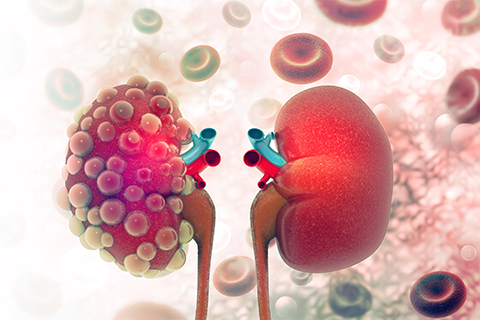From the journals: JBC
Protein cleavage in polycystic kidney disease. Expanding tools to study ion channels. Mechanisms of 5-fluorouracil cytotoxicity and chemoresistance. Read about papers on these topics recently published in the Journal of Biological Chemistry.
Protein cleavage in polycystic kidney disease

Autosomal dominant polycystic kidney disease, or ADPKD, is a genetic disorder characterized by oxidative stress, abnormalities reminiscent of the metabolic changes in cancer cells known as the Warburg effect, and fluid-filled cysts in the kidneys that can lead to end-stage renal failure. Mutations in the gene encoding the transmembrane protein polycystin-1, or PC1, can lead to accumulation of the entire protein and enhanced cleavage of its C-terminal end to create the 30 and 15 kiloDalton products associated with ADPKD. However, scientists do not yet know the precise mechanisms by which PC1 and the PC1 cleavage products drive cyst growth in this disease.
In a recent paper in the Journal of Biological Chemistry, Hannah Pellegrini, Elizabeth Sharpe, Guangyi Liu and colleagues at the University of California, Santa Barbara, describe how they showed that PC1-p30, normally rapidly degraded by the proteasome, is stabilized by reactive oxygen species and can localize to the nucleus and affect gene transcription. Using immunofluorescence, they demonstrated that PC1-p15 is generated by caspase cleavage of PC1 and localizes to the mitochondrial matrix. They further show that both of these cleavage fragments induce mitochondrial fragmentation and lactate production and impair fatty acid oxidation, inducing the aerobic glycolysis and mitochondrial dysfunction observed in the Warburg-like state characteristic of ADPKD.
These findings suggest novel mechanisms that regulate PC1 and its cleavage fragments, which contribute to the ADPKD disease phenotype. Further studies will be necessary to show the exact function of PC1 and its cleavage products in these biological processes.
DOI: 10.1016/j.jbc.2023.105158
Expanding tools to study ion channels
The voltage-gated sodium channel NaV1.5 is an essential channel protein that regulates the influx of sodium ions during action potentials, permitting the transmission of signals along neurons and regulating such diverse processes as sensation, muscle contraction and even behavior. The trafficking, pharmacology, and voltage-gating properties of NaV1.5 are regulated by interaction with five NaV beta-subunit isoforms, the loss of which can lead to arrhythmias including the heart signaling disorder known as long QT syndrome. However, the role of specific β-subunits is difficult to discern because endogenous proteins confound the results of existing overexpression models used to study their individual functions.
In a recent article in the Journal of Biological Chemistry, Annabel Minard, Colin Clark and colleagues at the University of Iowa College of Medicine describe a newly developed cell line devoid of expression of all five β-subunits as well as phylogenetically related proteins of the same β/myelin protein zero, or MPZ, subfamily. The researchers used CRISPR-Cas9 gene editing to generate this β-subunit-eliminated haploid, or BeHAPe, cell line and confirmed that exogenous expression of individual subunits had profound variable effects on voltage conductance as measured by patch clamping. They show that different β-subunits had different effects on NaV1.5 conductance-voltage and steady-state equilibrium as well as channel inactivation kinetics; furthermore, they found β2 co-expression could nullify β1-induced accelerated inactivation, while MPZ unexpectedly also affected the cell’s equilibrium potential.
These findings demonstrate the utility of a β-subunit-null cell line in differentiating the properties of multiple related proteins. While this model will be useful in elucidating functional outputs of interactions among specific combinations of NaV1.5 β-subunits, scientists will have to wait for structural data to fully understand the mechanisms by which these properties are conferred.
Mechanisms of 5-fluorouracil cytotoxicity and chemoresistance
Scientists recently found that aldehyde dehydrogenase 1 family member L2, or ALDH1L2, is a key enzyme in folate-mediated one-carbon metabolism, which is essential for basic cellular homeostasis as well as the enhanced proliferation commonly seen in cancer, via production of the cofactor tetrahydrofolate and the energy carrier nicotinamide adenine dinucleotide phosphate hydrogen, or NADPH. Although researchers know little about its potential roles in pathology, ALDH1L2 is overexpressed in many cancers and may contribute to the proliferation of cancer cells. Scientists are still investigating how ALDH1L2 could promote cancer cell metabolism, proliferation and metastasis.
In their new study published in the Journal of Biological Chemistry, Chaoqun Li, Peng Teng, Zhaohui Huang and colleagues at the Wuxi Cancer Institute in Jiangsu, China, investigated the role of ALDH1L2 in colorectal cancer treated with 5-fluorouracil, a chemotherapeutic agent. They used mass spectrometry to show that ALDH1L2 is acetylated at a specific lysine residue and that this posttranslational modification, which could be removed by the protein NAD+-dependent deacetylase sirtuin-3, or SIRT3, abolishes enzymatic activity. They also found that 5-fluorouracil treatment decreased SIRT3 expression in cells, suggesting SIRT3 is a previously unknown target for this drug and that its cytotoxicity could be mediated by inhibition of SIRT3- and ALDH1L2-regulated metabolism and disturbance of cellular redox balance.
These data identify a novel pathway of 5-fluorouracil activity, further illuminating its mechanism of action and mechanisms by which cancer cells might develop resistance to this drug. It remains to be seen whether combining 5-fluorouracil with a SIRT3 inhibitor could overcome this chemoresistance.
Enjoy reading ASBMB Today?
Become a member to receive the print edition four times a year and the digital edition monthly.
Learn moreGet the latest from ASBMB Today
Enter your email address, and we’ll send you a weekly email with recent articles, interviews and more.
Latest in Science
Science highlights or most popular articles

The science of staying strong
Muscles power every movement, but they also tell the story of aging itself. Scientists are uncovering how strength fades, why some species resist it and what lifestyle and molecular clues could help preserve muscle health for life.

Bacteriophage protein could make queso fresco safer
Researchers characterized the structure and function of PlyP100, a bacteriophage protein that shows promise as a food-safe antimicrobial for preventing Listeria monocytogenes growth in fresh cheeses.

Building the blueprint to block HIV
Wesley Sundquist will present his work on the HIV capsid and revolutionary drug, Lenacapavir, at the ASBMB Annual Meeting, March 7–10, in Maryland.

Gut microbes hijack cancer pathway in high-fat diets
Researchers at the Feinstein Institutes for Medical Research found that a high-fat diet increases ammonia-producing bacteria in the gut microbiome of mice, which in turn disrupts TGF-β signaling and promotes colorectal cancer.

Mapping fentanyl’s cellular footprint
Using a new imaging method, researchers at State University of New York at Buffalo traced fentanyl’s effects inside brain immune cells, revealing how the drug alters lipid droplets, pointing to new paths for addiction diagnostics.

Designing life’s building blocks with AI
Tanja Kortemme, a professor at the University of California, San Francisco, will discuss her research using computational biology to engineer proteins at the 2026 ASBMB Annual Meeting.

